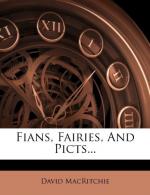This Nar is a very interesting personage in the present connection. Because, being one of the Tuatha Dea, she was a siabhra, or woman of the sidhs; otherwise, a bean-side (modernised into “banshee"). This is plainly stated in two other Irish manuscripts, with an additional explanation which is very apposite. It is said that Crimthann was called Nar’s Champion “because his wife Nar thuathchaech out of the sidhes, or of the Pict-folk [a sidaib no do Chruithentuaith], she it was that took him off on an adventure.” A companion statement is that made in another manuscript to the effect that “Nar thuathchaech, the daughter of Lotan of the Pict-folk [Nar thuathchaech ingen Lotain do Chruithentuaith], was the mother of Feradach finnfhechtnach,” or “the brightly prosperous”—a king of Ireland.[92]
Incidentally, therefore, in considering the Brugh of the Boyne and the people most associated with it, we find very distinct confirmation of the main part of the contention in the foregoing treatise. From these extracts it is evident that those early writers regarded siabhra, fear-sidh, bean-sidh, and daoine-sidh (words which may also be interpreted “mound-dweller”) as ordinary folk-names for the Picts; just in the same way as any historian of the frontier wars in North America would understand by “Red-skin” and “Greaser” the more classic “Indian” and “Mexican.”
[Footnote 76: Earlier illustrations, from drawings made in 1724 by Mr. Samuel Molyneux, a Dublin student, may be seen in Part II. of “A Natural History of Ireland,” Dublin, 1726. Other eighteenth-century representations of the same place occur in a volume of old plates, belonging to the Society of Antiquaries (London). This volume is endorsed “Celtic Remains; I,” and its contents form part of (says the fly-leaf) “a collection of plates from the Archaeologia collected by Mr. Akerman when the Society’s Stock was sold off and arranged more or less in Classes.” The views of the Brugh will be found at pp. 239, 253, and 254 (Plates XIX.-XXII.). Colonel Forbes Leslie has two excellent plates, from drawings of his own, in his Early Races of Scotland (Edin. 1866), vol. ii.; where he also refers to Wilde’s Boyne and Blackwater and Wakeman’s Irish Antiquities. A recent work, illustrating the same subject, but which I have not yet had an opportunity of seeing, is Mr. George Coffey’s “Tumuli and Inscribed Stones at New Grange, Dowth, and Knowth,” Dublin, 1893.]
[Footnote 77: Forbes Leslie’s Early Races of Scotland, vol. ii. p. 335, note.]
[Footnote 78: O’Curry’s Lectures, Dublin, 1861, p. 505.]
[Footnote 79: For most of which see Dr. Standish O’Grady’s Silva Gadelica, pp. 102-3, 146, 233, 474, and 484.]
[Footnote 80: Silva Gadelica (English translation), pp. 474 and 520.]
[Footnote 81: Op. cit. (English translation), p. 522.]




